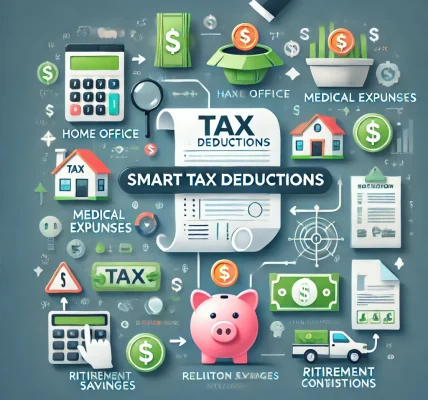Introduction
As the year comes to a close, individuals and business owners should take proactive steps to optimize their tax situations. Proper year-end tax planning can help reduce liabilities, maximize deductions, and ensure compliance with tax laws. By implementing strategic financial decisions before December 31st, you can effectively lower your taxable income and set yourself up for financial success in the upcoming year.
This DIY guide provides practical and legally compliant year-end tax planning tips to help you maximize your savings while staying within tax regulations.
1. Review Your Income and Expenses
Understanding your annual income and expenses is crucial for effective tax planning. Consider the following:
- Defer Income: If you expect to be in a lower tax bracket next year, deferring some income until January can reduce your current tax liability.
- Accelerate Deductions: Pay deductible expenses before year-end, such as business expenses, medical bills, or mortgage payments, to lower your taxable income.
2. Maximize Retirement Contributions
Contributions to retirement accounts not only help secure your future but also provide significant tax benefits:
- 401(k) Contributions: If your employer offers a 401(k), maximize your contributions to lower your taxable income.
- Traditional IRA Contributions: Contributions may be tax-deductible depending on your income level.
- Self-Employed Retirement Plans: Consider SEP-IRAs or Solo 401(k)s to reduce self-employment tax liabilities.
3. Take Advantage of Tax-Loss Harvesting
If you have investments in taxable accounts, you can offset capital gains by selling underperforming assets:
- Offset Gains: Use losses to reduce capital gains tax liability.
- Carry Forward Losses: If losses exceed gains, they can be carried forward to future tax years to lower tax burdens.
4. Utilize Charitable Donations
Giving to qualified charities not only benefits the community but also provides tax savings:
- Cash Donations: Contributions to recognized charities can be deducted if you itemize your deductions.
- Donating Appreciated Assets: Donating stocks or property can provide double tax benefits—avoiding capital gains tax and qualifying for a deduction.
- Qualified Charitable Distributions (QCDs): If you’re 70 1/2 or older, you can donate directly from your IRA to satisfy required minimum distributions (RMDs) while avoiding taxable income.
5. Use Flexible Spending Accounts (FSAs) and Health Savings Accounts (HSAs)
These accounts offer tax advantages for healthcare expenses:
- FSAs: Ensure you use any remaining funds before they expire at year-end (some plans allow limited carryover).
- HSAs: Contributions are tax-deductible, and withdrawals for qualified medical expenses are tax-free.
6. Consider Roth Conversions
Converting a traditional IRA to a Roth IRA can be beneficial if:
- You expect higher tax rates in the future.
- You can pay taxes now at a lower rate.
- You want tax-free withdrawals in retirement.
A Roth conversion strategy can help optimize your long-term tax situation.
7. Review Business Deductions and Credits
Small business owners can take advantage of various tax-saving opportunities:
- Section 179 Deduction: Deduct the full cost of qualifying equipment and software purchased before year-end.
- Home Office Deduction: If you work from home, claim deductions for a portion of rent, utilities, and internet expenses.
- Employee Retention Credit: If eligible, claim tax credits for retaining employees.
- Deferred Income Strategy: Delay client invoices to push income into the next tax year.
8. Pay Estimated Taxes
If you’re self-employed or have significant non-wage income, ensure you’ve made sufficient estimated tax payments to avoid penalties.
- Quarterly Payments: The IRS requires estimated payments throughout the year.
- Check Withholding: Adjust W-4 withholdings if necessary to prevent underpayment penalties.
9. Plan for State and Local Tax (SALT) Deductions
The SALT deduction allows taxpayers who itemize to deduct state and local taxes paid during the year.
- Prepay Property Taxes: If beneficial, pay next year’s property taxes before December 31st to increase deductions.
- State Estimated Taxes: Pay fourth-quarter state estimated taxes before year-end for deduction eligibility.
10. Stay Updated on Tax Law Changes
Tax laws change frequently, and staying informed can help you take advantage of new deductions or credits.
- Review IRS Updates: Check for any new tax provisions that may apply to your situation.
- Consult a Tax Professional: A CPA or tax advisor can provide personalized strategies to maximize tax savings.
Conclusion
Year-end tax planning is essential for minimizing liabilities and maximizing financial savings. By implementing these strategies, you can take full advantage of deductions, credits, and tax-saving opportunities before the new year begins.
Proactively managing your taxes can reduce financial stress, improve cash flow, and ensure compliance with tax laws. If you have complex financial situations, consulting a tax professional can help you navigate tax planning effectively.




